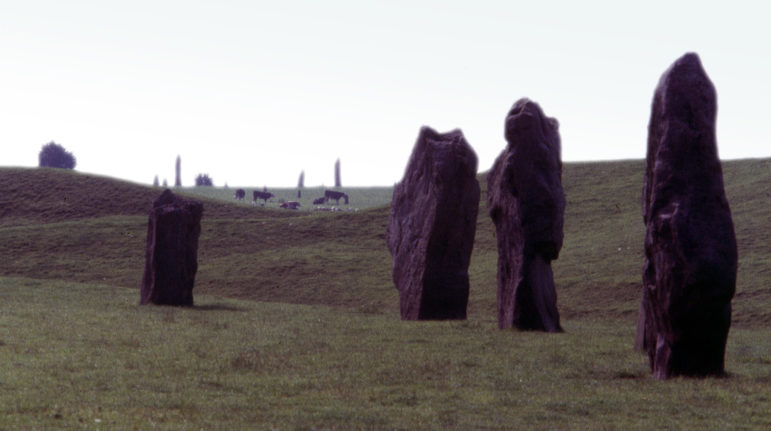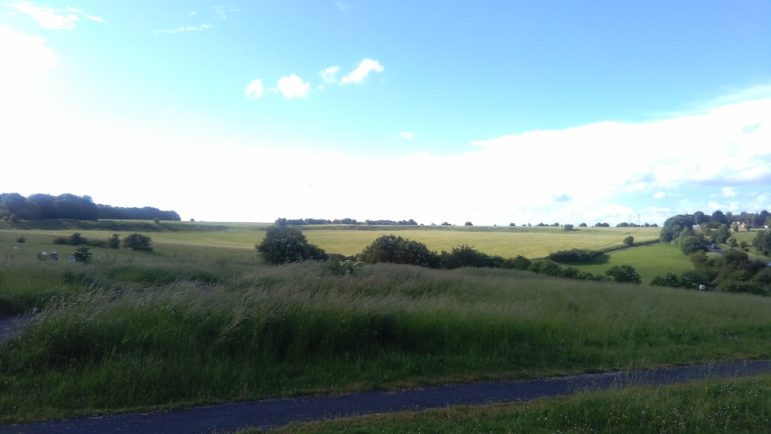TWH – During the Neolithic period, the island of Britain produced a large number of monuments. Many monuments are of stone, but others were made of wood. A common question for both is how long it took for the builder to construct the monuments.
Henges are prehistoric monuments that consist of a circle of upright stones or timber. Researchers from Cardiff University reported recently findings from radiocarbon dating of timber to estimate how long it took to build the Mount Pleasant Henge.

Mount Pleasant Henge, just outside of Dorchester, Dorset. A heavily-eroded Neolithic henge is visible as a white crop-mark in this spring photograph. A Bronze-Age barrow (known as Conquer Barrow) on the western edge of the henge can be seen in the background. Image credit: Pasicles – CC0
The researchers presented evidence that ancient peoples built that complex henge within 125 years, around 2500 B.C.E. People were also bringing the Sarsen stones to Stonehenge at about the same time. Shortly after completion of the Mount Pleasant Henge, artifacts from the Beaker Culture begin to appear in Britain. The Neolithic was ending, and the Bronze Age was beginning.
A series of concentric circular enclosures characterize the Mount Pleasant Henge. The last enclosure, Site IV, surrounds a square-in-a-circle structure of four posts. Ritualists might imagine these circular enclosures as separating sacred from mundane space. They might also imagine the final enclosures of the unimaginatively labeled “Site IV,” to be an inner sanctum. The square-in-a-circle might contain an altar.
Other Neolithic monuments, like Stonehenge and Newgrange, align with the Winter Solstice. At present, no one knows if the Mount Pleasant Henge aligns with any astronomical event.
The Mount Pleasant Henge forms part of the Dorchester ceremonial complex. That term refers to a cluster of monuments in close proximity. Those monuments appear to have had some type of ritual function. Located between the Rivers Fromme and the South Winterbourne in Dorset, the complex lies near the modern city of Dorchester.
Six other major monumental structures along with the Mount Pleasant Henge form the Dorchester Ceremonial Complex.
The six other major structures are Maiden Castle, Maumbury Rings, Conygar Hill, Greyhound Yard, Alington Avenue, and the Flagstones.
They collectively include barrows, enclosures, and fenced (palisaded) enclosures. The complex is also the site of adult cremations and child burials.
The physicality of the Mount Pleasant Henge
This henge has the form of an irregular oval, with a commanding view of a fording point on the River Fromme. It runs 370 m (1,214 ft) from west to east and 320 m (1050 ft) from north to south.
It has structural similarities to four other large henges in Britain. Three henges are located in Wiltshire: Marden, Durrington Wall, and Avebury. The Knowlton Henge is also located in Dorset. This similarity and proximity indicate regular contact and elements of a common culture.

Avebury (1985) – Image credit: Gerd Eichmann – CC BY-SA 4.0
Six major elements constitute Mount Pleasant henge: an outer ditch, a raised bank, the Conquer Barrow, an inner ditch, a circular palisade, and Site IV that is a timber and stone monument.
Every major element has the form of concentric enclosures. The bank and ditches have five entrances.
The Conquer Barrow, a large round mound, had been built atop the outer bank near its western entrance. It rises 3 to 4 m (9 to 13 ft) above the henge bank of 4 m (13 ft). It has a diameter of 30 m (98 ft). Given the certainty of erosion, it would have stood taller in the Neolithic.
Inside the inner ditch, stood the circular palisade. About 1600 posts formed this circular palisade. The posts stood in a trench 1 to 2 m wide (3 to 6 ft). The postholes had a depth of 2.5 to 3 m (8 to 10 ft). Archaeologists estimate that each post would have stood 6 m high (20 ft) and would have been oak. This palisade had two narrow entrances on its northern and eastern sides. Massive wooden posts 1.8 m (6 ft) in diameter flanked each narrow entrance.
Sections of the palisade showed evidence of burning. Other sections show evidence of deliberate removal while others showed evidence of rotting in place. This selective destruction may reflect planned ritual activity, social unrest, or a hostile attack.
Within these four concentric circular enclosures, stood a concentric timber and stone monument, Site IV. People would have entered Site IV through a causeway to its north. Its surrounding circular ditch has a diameter of 43 m (141 ft). Within that ditch are five circular rings of postholes. In the center, four pits form a square. If these pits held upright posts or stones, it would be consistent with other “square-in-circle” monuments on the island of Britain.

Durrington Walls henge, viewed here bathed in sunlight. Viewed from the east. Image credit: Pasicles – CC0
Labor, the Henge, and social unrest
The henge required a large amount of wood. No evidence shows that this area was forested in the Neolithic. The builders of the henge would have had to organize major forestry operations to secure the needed wood. They would have had to draw on forests distant from Mount Pleasant.
The charcoal evidence from the site indicates a preference for oak. In the Neolithic, oak was a common choice. Different villages may have brought wood to Mount Pleasant. On a material level, that would solve the problem of their harvesting enough wood for construction. On an animistic level, the presence of wood linked to a specific village could have linked that village with the ritual activity at the site. Selective burning or removing of specific posts could represent ritual expulsion or secession of specific villages.
The article failed to discuss an obvious problem. Antler picks were the shovels of the Neolithic. In a time without labor-saving devices, everything was labor-intensive. The henge would have required a labor force for construction and wood harvesting. The shorter the time for construction, the larger the labor force would have to be.
People working in forestry and construction would not be producing food. They would, however, still be eating food. Unless an agricultural surplus existed, this could have led to social instability. That instability could explain the selective burning of the palisades. That instability could also have weakened the local power elite enough to facilitate the coming of the Bell Beaker culture.
Stone monuments like Stonehenge have endured. Wooden henges rotted over time, however. In the Neolithic, easier to build wood henges that would have been much more common than megaliths. Their remains are much less impressive to modern observers of the sites but still major acts of architecture and community activity. They are critical for understanding ritual practice in the Neolithic.
The Wild Hunt is not responsible for links to external content.
To join a conversation on this post:
Visit our The Wild Hunt subreddit! Point your favorite browser to https://www.reddit.com/r/The_Wild_Hunt_News/, then click “JOIN”. Make sure to click the bell, too, to be notified of new articles posted to our subreddit.